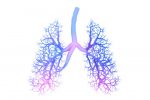High Levels of IL-35, a Signaling Molecule, May Slow PF Progression
Written by |

A signaling molecule called interleukin 35 (IL-35) is at unusually high levels in lung tissues from mice and in people with pulmonary fibrosis (PF), and seems to play a role in slowing disease progression, a study found.
These findings indicate that IL-35 might be a new therapeutic target for a disease with “few treatment options,” its scientists wrote.
The study, “IL-35 subunit EBI3 alleviates bleomycin-induced pulmonary fibrosis via suppressing DNA enrichment of STAT3,” was published in the journal Respiratory Research
IL-35 is a protein produced by regulatory T-cells — a type of immune cell that fine-tunes the body’s immune response by suppressing it — and which plays an important role in immunosuppression. IL-35 is a heterodimer, meaning it is made up of two different chains of amino acids, which are the basic building blocks of proteins. Each of the two chains, IL12A and EBI3, is encoded by its own gene.
Previous research hinted that EBI3 — the gene that provides instructions to make the EBI3 chain — is overactive in the lungs of mice injected with bleomycin, a chemical that causes tissue injury and scarring (fibrosis) and is used to model PF in rodents.
A team of researchers in China used genetic manipulation to strip the EBI3 gene from a group of mice. These animals, called knock-out (KO) mice, were then used to explore the role IL-35 plays in scarred lungs.
As a first step, researchers confirmed that IL-35 levels were indeed increased in lung tissues and blood from mice with bleomycin-induced PF, compared with animals injected with a saline solution that served as controls.
Next, they took blood samples from 17 patients with PF (ages 20–58) and 18 healthy people (ages 29–58) and watched for changes in the levels of IL-35 in peripheral blood mononuclear cells (immune cells circulating in the bloodstream). They found that IL-35 was higher in cells taken from PF patients compared with healthy individuals.
To find out what happens when the EBI3 chain is missing, researchers watched for changes in lung tissues in KO and non-KO mice four weeks after bleomycin exposure in both groups. They found that KO mice had more scarred and stiffer lung tissues, and more severe disease than mice that retained the EBI3 gene. These findings suggested that a lack of EBI3 worsened PF symptoms in mice.
“Knockdown of IL-35 subunit EBI3 increased the expression of a variety of fibrosis-related genes and aggravated the symptoms of bleomycin-induced pulmonary fibrosis in [the] mouse model,” the researchers wrote.
Fibrosis is marked by an excessive accumulation of collagen and other extracellular matrix components that make up the network that surrounds and supports cells. To understand how EBI3 works, researchers looked at the expression levels (activity) of genes that provide instructions to make those components. They found that a lack of EBI3 resulted in an increased expression of those genes.
Researchers then used mouse cells isolated from the lining of their lungs to look more closely at the effect of IL-35. They found that IL-35 activates STAT proteins, which are involved in cell growth and survival. This might be the mechanism by which IL-35 is able to inhibit the production of extracellular matrix components, they noted.
Whether the effect of IL-35 is restricted to the lungs is still unclear, the researchers wrote. But if what was seen in mice is similar to what happens in people, “IL-35 might be one of the potential therapeutic targets for the treatment of pulmonary fibrosis,” they added.







